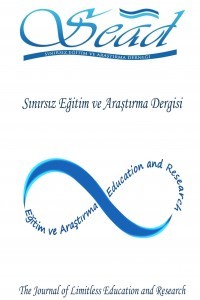Okuma Yazma Öğrenmede Zihin Açıklığı
Zihin açıklığı, çabuk kavrama, anlama, öğrenme, doğru düşünme, başarılı olma gibi anlamlarda kullanılmaktadır. Okuma yazmada zihin açıklığı, öğrencinin sözlü ve yazılı dilin yapısı ile özelliklerini iyi anlaması, dilin teknik terimlerini öğrenmesini içermektedir. Bu anlayışla çeşitli araştırmalar yapılmış ve Okuma Yazma Öğrenmede Zihin Açıklığı Teorisi geliştirilmiştir. Bu teori okuma yazma öğrenme süreçlerini geliştirme, çocukların zihninde açık hale getirme ve öğrenme sürecini kolaylaştırma amaçlı eğitsel bir teoridir. Öğrencilerin okuma yazma etkinliklerinin mantığı, işlevi ve özelliklerini iyi anlaması üzerine kuruludur. Bu teoriye göre okuma yazma öğrenme süreci zihin aşaması, geliştirme aşaması ve bağımsız uygulama aşaması olmak üzere üç aşamada gerçekleşmektedir. Eğer bu aşamalar çok hızlı geçilir, yeterli etkinlikler yapılmazsa öğrencilerde zihinsel karışıklık olmakta, okuma yazma öğrenme güçleşmektedir. Bu durumu önlemek için zihin aşamasına öncelik verilmesi ve gerekli çalışmaların yapılması öngörülmektedir. Öğrencilerde zihin açıklığını değerlendirmek için çeşitli ölçme araçları da geliştirilmiştir. Bu araçlar çeşitli okullarda uygulanmaktadır. Zihin açıklığı konusunda çeşitli üniversitelerde araştırma ve tez çalışması yapılmaktadır. Bu konunun ülkemizde de ele alınması ve öğrencilerimize daha kolay okuma yazma öğretilmesi önerilmektedir.
Anahtar Kelimeler:
Okuma, Yazma, Zihin açıklığı
Cognitive Clarity in Reading and Writing
Cognitive clarity is used in terms of quick-grasp, comprehension, learning, thinking correctly, and success. Cognitive clarity in reading and writing comprises students' understanding of the structure and characteristics of oral and written language, and their learning of the technical terms in that language. Within this manner, several studies are conducted and Cognitive Clarity Theory in literacy is improved. This theory is an educational theory to aim at developing the learning processes of reading and writing, making it clear in students' minds and facilitating their learning process. The rationale of literacy activities of students is based on understanding of functions and features of the language. According to this theory, literacy learning process takes place in three stages: mind stage, development stage, and independent implementation stage. In case these stages are applied fast, and efficient activities are unfulfilled, students have cognitive derangement and literacy learning becomes hard. In order to prevent this situation, it is foreseen that priority should be given to the mind phase and necessary studies should be carried out in this field. In order to evaluate the clarity of mind in students a variety of measurement tools have been developed and implemented in various schools. Currently, research and dissertation studies on cognitive clarity are carried out in various universities. It is suggested that these studies should be taken into account in our country as well and more easily literacy teaching is recommended to Turkish students.
Keywords:
Reading, Writing, Cognitive clarity,
___
- Bernardin J. (1997). Comment les enfants entrent dans la culture écrite, Paris: Retz.
- Bonjour, E. & Gombert, J. E. (2004). Profils de lecteurs à l’entrée en sixième. L’Orientation Scolaire et Professionnelle, 33(1), 69-101.
- Borsali-Mayouf, N.(2012). La compréhension des élèves face aux situations d’apprentissage en EPS. Education. 2012.
- Crinon,J. Espinosa,N. Gremmo, M-J. Jarlégan,A. Kreza,M et Leclaire-Halté,A.(2015).Clarté cognitive et apprentissage du lire-écrire au CP : quelles pratiques enseignantes?Pratiques, 165-166, DOI : 10.4000/pratiques.2586
- De Croos,C.(2004). Traces écrites d’élèves de cycle 2 : Clarté cognitive et modalités d’entrée dans l’écrit, Recherches n° 41, 2004
- Downing,J. ve Fijalkow,J. (1984). Lire et raisonner, Toulouse: Privat.
- Dupuy-Kuntzmann,L.(2013). Clarte cognitive et apprentissage de la lecture-ecriture,Education,Hal Id: dumas-00935277, https://dumas.ccsd.cnrs.fr/dumas-00935277
- Ehrlich S.,Bramaud Du Boucheron, G., Florin, A. (1978), Le développement des connaissances lexicales à l’école primaire, Paris:PUF.
- Fayol M., Gombert J. E., Lecocq P., Sprenger-Charolles L., Zagar D. (1992). Psychologie cognitive de la lecture, Paris:Pug, Psychologie d’aujourd’hui.
- Ferreiro, E., Gomez-Palacio, M.(1988). Lire-écrire à l’école, comment s’y apprennent-ils ?Lyon :CRDP.
- Ferreiro, E. (2001). Culture et éducation. Paris : RETZ.Fijalkow ,É. (1993)."Clarté cognitive en grande section maternelle et lecture au cours préparatoire", dans L’enfant apprenti lecteur. L’entrée dans le système écrit, INRP CRESAS n°10, L’Harmattan, p. 83-104.
- Fijalkow J. (1996). Entrer dans l’écrit, Les guides Magnard.
- Fijalkow J. ve Liva, A. (1993). Clarté cognitive et entrée dans l’écrit : construction d’un outil d’évaluation, in Grégoire J. et Piérart B., Évaluer les troubles de la lecture, Les nouveaux modèles théoriques et leurs implications diagnostiques.Bruxelles:DeBoeck.
- Güneş, F.(2007).Ses Temelli Cümle Yöntemi ve Zihinsel Yapılandırma.Ankara:Nobel .
- Leclercq,V. Viriot-Goeldel,C.Gallet.C.(2015). Les difficultés en lecture à l’école primaire :une prise en charge précoce et sur le long terme.Developpement, no:18-19, numéro spécial : Journée scientifique de la SOFTAL, Lyon, 9 juin 2015. Rigal, R. (2003). L’apprentissage moteur , Motricité humaine, Fondements et applications pédagogiques. Tome 2, Développement moteur, Presses de l'Université du Québec,3e édition, p.295/296, ISBN 9782760517264
- Yayın Aralığı: Yılda 3 Sayı
- Başlangıç: 2016
- Yayıncı: Sınırsız Eğitim ve Araştırma Derneği
Sayıdaki Diğer Makaleler
Probleme Dayalı FeTeMM Uygulamalarının Akademik Başarıya Etkisi
Ayşegül ERGÜN, Muhammed Doğukan BALÇIN
Eğitimde Bilimsel Argumantasyon Üzerine Ulusal ve Uluslararası Çalışmaların İncelenmesi
Okuma Yazma Öğrenmede Zihin Açıklığı
Ortaokul Matematik Öğretmeni Adaylarının İspatın Doğasına İlişkin Görüşleri
